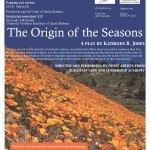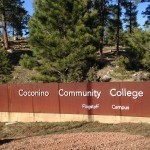Kathleen B. Jones's Blog
August 4, 2018
Cities of Women, a novel
 I may have been silent about my writing for some time, but I have not been inactive.
I may have been silent about my writing for some time, but I have not been inactive.
Just returned from an eight-day writing residency on Enders Island, Connecticut, a program sponsored by Fairfield University as part of the M.F.A. in creative writing, which I began this summer. (Yes, you read that correctly. I have begun graduate studies in creative writing on the cusp of my 70th birthday. Why not?)
I’ve had a novel in mind for more than a decade and I am finally getting it into shape, with the help of excellent faculty guidance and collegial support.
Here’s the concept:
While researching Christine de Pizan’s manuscripts, Prof. Verity Frazier stumbles upon evidence indicating some of the most beautiful designs in the collection have been the handiwork of a woman. The novel flashes back to the fourteenth and early fifteenth centuries to recreate an imagined relationship between Christine de Pizan and Héloise Tapis, a remarkable woman employed by de Pizan to illuminate her manuscripts.
The obstacles facing these women in the past reverberate into the present as the novel returns to the 21st century when Prof. Frazier confronts resistance from to her efforts to document Tapis’s significance in Pizan studies.
Exploring themes of religious scandal, political corruption, catastrophic disease, and gender and class conflict through the lens of an era the historian Barbara Tuchman called “a distraught age whose rules were breaking down under the pressure of adverse and violent events,” the story tracks a time remarkably similar to our present.

Parchment
The research has been an extraordinary experience for me, taking me to the Morgan Library, where I learned about parchment production, and the British library in London, whose collections of Christine’s works provide the setting for some of the novel’s contemporary scenes.

Page of Christine’s MSS, British Library.
But it’s the imaginative process of writing that will engage me fully in the coming months, as I develop further the voice, character, and structure with which to tell this story. I have had the expert guidance of Eugenia Kim, whose novel writing workshop at Enders spurred me further into the development of my craft. And I will be working with Karen Osborn this fall on structure and voice in the novel.
Stay tuned for further updates.

December 30, 2016
Loss and Mourning and Beginning Again
It seems loss and mourning intend to remain my regular companions on and off the stage. Last month, in my new play, The Origin of the Seasons, I plumbed these subjects. They returned with an unexpected alacrity to trouble my thinking.
A few weeks ago, my brother-in-law lost a brief, valiant battle with brain cancer. He was gone before any of us could even wrap our minds around his diagnosis.
After a keen and graceful marriage of 42 years, my sister’s wounded heart needs special healing. She’s found solace in revisiting family photo albums; a few books (Chasing Daylight by Eugene O’Kelly among them) offered insight into what her husband was experiencing. Like O’Kelly, my sister told me, her husband tried to make the most of his last months of life: giving away special things to people and groups he loved, visiting with close family and friends. And laughing a lot. He even made a list of who not to invite to his memorial!
“For a guy who led a quiet life,” my sister said, “he suddenly wanted to be visited by more and more people; he created a very busy social calendar to manage. It was exhausting. But I understand now why it mattered so much to him. He was preparing to leave. It was exactly what he needed to do.”
I’m grateful I could be with her during the shocking first days following her husband’s death. As she tried to keep putting one foot after another along this uneven new path in that ever-unpredictable journey we call “life,” we busied ourselves with details—financial matters, writing the obituary, planning the celebration of his life.
One morning, my sister pointed to the tiny Chinese Elm Bonsai her husband had tended so carefully for a dozen years.
“Have you noticed what’s happening to his Bonsai?”
I hadn’t.
“I’ve done everything as he instructed. Watered it lightly and not too frequently. But it must know; on some deep cellular level it’s connected to him. Because it’s dying now too.”
I watched in amazement over the next few days as the tiny tree’s leaves continued to fade from bright green to dust.
I finished reading Oliver Sacks’ memoir, On The Move: A Life, while I stayed with my sister. It’s a lucid appraisal of Sacks’ life and work, including this latest, and last, stage, of his having terminal cancer.
Never having given much thought to death or dying, even though he had “lost all three of [his] elder brothers, as well as many friends and contemporaries,” Sacks describes being thrown from one extreme emotion to another—“from terror to relief, then back to terror”—during the course of his initial treatments. He was able to keep the cancer at bay for nearly nine years. But recently he learned it had metastasized to his liver. As he wrote in the New York Times opinion pages, “It is up to me now to choose how to live out the months that remain to me. I have to live in the richest, deepest, most productive way I can.”
So much prevents or distracts from rich, deep living; so much enables us to ignore mortality. Perhaps we must ignore it, at least for some important part of the unknown time we walk on this earth.
That element of tragedy which lies in the very fact of frequency, has not yet wrought itself into the coarse emotion of mankind; and perhaps our frames could hardly bear much of it. If we had a keen vision and feeling of all ordinary human life, it would be like hearing the grass grow and the squirrel’s heart beat, and we should die of that roar which lies on the other side of silence. As it is, the quickest of us walk about well wadded with stupidity. (George Eliot, Middlemarch)
Yet, paradoxically, to ignore it altogether is equally, fatally perilous.
The Origin of the Seasons will be performed at Unity Santa Barbara in Santa Barbara on June 7th (2015) at 7 P.M. in a reprisal by the original cast from Flagstaff Arts and Leadership Academy.

August 11, 2015
Alternative Academic Publishing?
 I was invited by Prof. Janni Aragon, Director of University of Victoria’s (B.C. Canada) Technology Integrated Learning to give a presentation about my exploration of new directions in academic publishing.
I was invited by Prof. Janni Aragon, Director of University of Victoria’s (B.C. Canada) Technology Integrated Learning to give a presentation about my exploration of new directions in academic publishing.
My interest in this subject was motivated, in part, by my own experiences publishing my award-winning Diving For Pearls: A Thinking Journey with Hannah Arendt. What I learned in the course of this experience I wanted to share and that led me to more research being conducted on ways to wrest control over intellectual property from the commercial forces that have been been dominating the licensing and distribution process.
A variety of folks have been studying the interests dominating the field of scholarly publications and questioning why more academics (both independent scholars and university-based researchers) haven’t been pushed for changing the publishing landscape to better serve the interests of knowledge production and wider access to the results of scholarship.
I believe the tools of our liberation from a regime of commercial control over and profiteering from (often) publicly funded research are within our grasp IF we are willing to create collaborative teams willing to explore the options available through new technologies.
Many of those who attended my presentation were librarians, who are very much in the vanguard of seeking change that will better serve academic interests, broadly defined. As one of them said, “we’ve been telling faculty for years that the current citational practices of measuring the value of scholarly research are not serving faculty or wider academic interests. But not much has changed.”
There are many others investigating the ways to bring change, some of whom I cite in my presentation. New licensing methods, such as those offered by Creative Commons, and new delivery methods (including on-demand publication and internet based journals and blogs) can bring greater control over our intellectual property back into the hands of those who create it. If we are also willing to explore ways to measure “impact” and “value” differently from current practices.
I am posting a copy of my presentation here, with its Creative Commons license, encouraging you to share!
Alternative Pathways tp Academic Publishing? by Kathleen B. Jones. Ph.D. is licensed under a Creative Commons Attribution-NonCommercial 4.0 International License.
June 4, 2015
Diving for Pearls Wins “Kanner Award” from Western Association of Women Historians (WAWH)
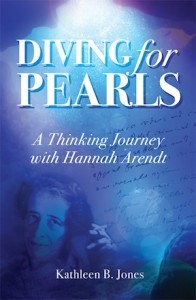 Earlier this week, I shared a story of loss. But, as is the case with so much in life, I’ve been given the chance today to share a different kind of story.
Earlier this week, I shared a story of loss. But, as is the case with so much in life, I’ve been given the chance today to share a different kind of story.
Diving for Pearls: A Thinking Journey with Hannah Arendt was honored with the Barbara “Penny” Kanner Award from the Western Association of Women Historians (WAWH) earlier this month. This annual award, established two decades ago, is given to a “book chapter, article, or electronic media that has been verifiably published or posted in the two years prior to the award year and which illustrates the use of a specific set of primary sources (diaries, letters, interviews etc).” This year, my book was chosen by the committee to receive the prize.
In March, I’d been informed of winning the award but was asked not to make the news public until the WAWH announced it. So I kept quiet (not easy to do because I was so excited my book was honored!) and looked forward to attending the meeting and awards’ banquet in Sacramento in May. Events made my attendance not possible.*
Today I received the WAWH newsletter with the public announcement and was especially touched by the words crafted by Nwando Achebe, chair of the Kanner Award committee, who teaches history at Michigan State, and was herself a Kanner Award winner for her book, The Female King of Colonial Nigeria: Ahebi Ugbabe (Indiana University Press, 2011). Here’s how she described my book:
Diving For Pearls is a memoir, biography, political and philosophical discussion of two women, the author Kathleen Jones and the philosopher Hannah Arendt. This intensely personal and incredibly brave autobiography/ biography is a deeply feminist undertaking in which the author takes her readers on a “thinking journey”; interrogating her own experience, reading deeply, and producing, through identification and empathy, a double memoir, or put differently, a scholarly discovery, which is as alive as it is personal. A daring and novel approach to her subject, Diving For Pearls represents an intervention into genres of scholarly presentation, and, in a somewhat more “conventional” way, debates about Hannah Arendt, one of the most complex and controversial philosophers of the twentieth century. It is as well about the radical positionality of the author, Kathleen Jones, writing on history, experience, memory, and meaning making.
I immediately wrote to Prof. Achebe and the executive director of the WAWH, thanking them, again, for the award:
I just read the way my book was described in the prize announcement and I was so touched by what you wrote. Those words meant more to me than almost anything else that has been said about the book; you understood exactly what I was trying to do. Thanks! I wish to volunteer to serve on one of the prize committees, to repay the honor I have received.
Within moments, Cheryl Warsh, executive director of WAWH, wrote to say they’d be delighted to have me serve on the committee. I look forward to reading nominees for next year’s Kanner Award.
The WAWH was founded in 1969, the same year the Department of Women’s Studies at SDSU was created, where I taught for 24 years. In 1980, I arrived in California and when I discovered the WAWH I knew I’d found a group of lively, like-minded scholars in an organization whose mission is to “promote the interests of women historians both in academic settings and in the field of history generally.”
I still remember WAWH conferences I attended in the 80s, presenting some of my early interdisciplinary historical research and receiving incredible, insightful commentary and support from the group. When, all too often, academia seems to be an arena of competition and one-ups-person-ship, the WAWH remains a beacon of open exchange of ideas, welcoming both academically affiliated and independent scholars, as well as graduate students, as doctoral student Sarah Ruth Wilson noted in her blog report on the conference, and doctoral student Andrea Milne wrote on hers.
As I moved in different directions over the years of my academic career, I shifted my membership away from WAWH to other professional associations and, eventually, to groups outside academia. Serendipitously, I rejoined this year and now, serving on one of its committees, will extend my membership further.
Of course, I’ll also have one of my other feet in other creative associations of dramatists, writers, and eclectic artists of various stripes. But that’s just multi-podal me continuing along a multi-routed path.
*The meeting happened to be in the same week I spent with my sister while her husband was in the final throes of a terminal illness.
June 2, 2015
Loss and Mourning and Beginning Again
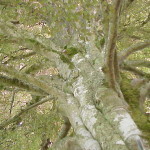 It seems loss and mourning intend to remain my regular companions on and off the stage. Last month, in my new play, The Origin of the Seasons, I plumbed these subjects. They returned with an unexpected alacrity to trouble my thinking.
It seems loss and mourning intend to remain my regular companions on and off the stage. Last month, in my new play, The Origin of the Seasons, I plumbed these subjects. They returned with an unexpected alacrity to trouble my thinking.
A few weeks ago, my brother-in-law lost a brief, valiant battle with brain cancer. He was gone before any of us could even wrap our minds around his diagnosis.
After a keen and graceful marriage of 42 years, my sister’s wounded heart needs special healing. She’s found solace in revisiting family photo albums; a few books (Chasing Daylight by Eugene O’Kelly among them) offered insight into what her husband was experiencing. Like O’Kelly, my sister told me, her husband tried to make the most of his last months of life: giving away special things to people and groups he loved, visiting with close family and friends. And laughing a lot. He even made a list of who not to invite to his memorial!
“For a guy who led a quiet life,” my sister said, “he suddenly wanted to be visited by more and more people; he created a very busy social calendar to manage. It was exhausting. But I understand now why it mattered so much to him. He was preparing to leave. It was exactly what he needed to do.”
I’m grateful I could be with her during the shocking first days following her husband’s death. As she tried to keep putting one foot after another along this uneven new path in that ever-unpredictable journey we call “life,” we busied ourselves with details—financial matters, writing the obituary, planning the celebration of his life.
One morning, my sister pointed to the tiny Chinese Elm Bonsai her husband had tended so carefully for a dozen years.
“Have you noticed what’s happening to his Bonsai?”
I hadn’t.
“I’ve done everything as he instructed. Watered it lightly and not too frequently. But it must know; on some deep cellular level it’s connected to him. Because it’s dying now too.”
I watched in amazement over the next few days as the tiny tree’s leaves continued to fade from bright green to dust.
I finished reading Oliver Sacks’ memoir, On The Move: A Life, while I stayed with my sister. It’s a lucid appraisal of Sacks’ life and work, including this latest, and last, stage, of his having terminal cancer.
Never having given much thought to death or dying, even though he had “lost all three of [his] elder brothers, as well as many friends and contemporaries,” Sacks describes being thrown from one extreme emotion to another—“from terror to relief, then back to terror”—during the course of his initial treatments. He was able to keep the cancer at bay for nearly nine years. But recently he learned it had metastasized to his liver. As he wrote in the New York Times opinion pages, “It is up to me now to choose how to live out the months that remain to me. I have to live in the richest, deepest, most productive way I can.”
So much prevents or distracts from rich, deep living; so much enables us to ignore mortality. Perhaps we must ignore it, at least for some important part of the unknown time we walk on this earth.
That element of tragedy which lies in the very fact of frequency, has not yet wrought itself into the coarse emotion of mankind; and perhaps our frames could hardly bear much of it. If we had a keen vision and feeling of all ordinary human life, it would be like hearing the grass grow and the squirrel’s heart beat, and we should die of that roar which lies on the other side of silence. As it is, the quickest of us walk about well wadded with stupidity. (George Eliot, Middlemarch)
Yet, paradoxically, to ignore it altogether is equally, fatally perilous.
The Origin of the Seasons will be performed at Unity Santa Barbara in Santa Barbara on June 7th (2015) at 7 P.M. in a reprisal by the original cast from Flagstaff Arts and Leadership Academy.
April 6, 2015
Origin of the Seasons Premieres in Flagstaff, AZ
I was in Flagstaff, AZ in late March for the premiere of my new play. The Soroptimists’ International of Flagstaff AZ, a women’s group whose mission is to be “an organization of women at their best helping other women to be their best,” sponsored an event on March 26 to launch their new youth empowerment program aimed at educating youth about the risks of violence against women. The event was held on the beautiful campus of Coconino Community College (CCC) in Flagstaff. And my new play, Origin of the Seasons was part of the program.
Given the community educational program, I couldn’t have asked for a better setting for the play’s first public viewing. And, adding to the excitement, Myra Ferell-Womochil, Executive Director of the Victim Witness Services of Flagstaff, and a women’s studies professor at NAU, was being honored as a Woman of Excellence at the event for her work on domestic violence prevention.
But how did it all happen? Serendipity!
It turns out that Leah Norris, who is interning with the Soroptimists and working on their new Empowerment project while she finishes her studies at CCC, has a daughter in FALA’s acting program. Coming from a family of theater fanatics, when she learned about my play and FALA’s collaboration with Northland Family Protection Services, she immediately contacted FALA teacher Mike Levin, who is directing the production, and asked to read the play. Then she circulated it among the Soroptimists, who decided it would make the perfect complement to their March program.
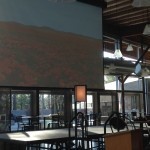 This first studio performance of the play was a sort of penultimate dress rehearsal before the premiere at Coconino Center for the Arts March 28-29. (By the way, Flagstaff’s Arizona Daily Sun featured the upcoming performances at CCA as a “hot pick” of the week in the arts!) The CCC venue presented challenges: the space was a large, open plan “Commons” with very high ceilings and difficult acoustics. But the CCC sound engineer set up a boom mic and the performers gave it their all. The result: astonishing!
This first studio performance of the play was a sort of penultimate dress rehearsal before the premiere at Coconino Center for the Arts March 28-29. (By the way, Flagstaff’s Arizona Daily Sun featured the upcoming performances at CCA as a “hot pick” of the week in the arts!) The CCC venue presented challenges: the space was a large, open plan “Commons” with very high ceilings and difficult acoustics. But the CCC sound engineer set up a boom mic and the performers gave it their all. The result: astonishing!
The performances that followed this “dress rehearsal” were held at the Coconino Center for the Arts in Flagstaff. The actors gave it their all and the result was a spectacular premiere.
Here is a collage of photos taken by the magnificent Rick Johnson, who photographed the show.
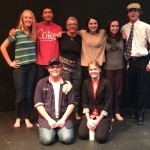 I cannot believe what these young artists achieved. Actually, I can believe it, given their dedication and the artistic creativity and dedication of their incredible teacher, Mike Levin.
I cannot believe what these young artists achieved. Actually, I can believe it, given their dedication and the artistic creativity and dedication of their incredible teacher, Mike Levin.
Mike’s been nominated for a Tony’s Excellence in Theater Education Award, the first of its kind to be awarded this spring. We are all pulling for the Tony Committee and Carnegie Mellon, who are sponsoring the award, to recognize this amazing teacher’s contributions to the arts.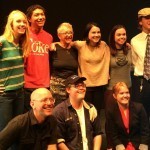
If ever you despair about the difference education makes in the lives of youth, just think about this collaborative project Mike helped bring into the world. Life-changing, all around. Here’s the video his students made for the nomination application packet:
Levin Nomination Video from Kathleen Jones on Vimeo.
March 30, 2015
Origin of the Seasons at Coconino Community College & Coconino Center for the Arts, Flagstaff, AZ
I’ve been in Flagstaff, AZ for the past few days for the premiere of my new play. Last Thursday night (March 26th) the Soroptimists’ International of Flagstaff AZ, a women’s group whose mission is to be “an organization of women at their best helping other women to be their best,” sponsored an event to launch their new youth empowerment program for, aimed at educating youth about the risks of violence against women. The event was held on the beautiful campus of Coconino Community College (CCC) in Flagstaff. And my new play, Origin of the Seasons was part of the program.
Given the community educational program, I couldn’t have asked for a better setting for the play’s first public viewing. And, adding to the excitement, Myra Ferell-Womochil, Executive Director of the Victim Witness Services of Flagstaff, and a women’s studies professor at NAU, was being honored as a Woman of Excellence at the event for her work on domestic violence prevention.
But how did it all happen? Serendipity!
It turns out that Leah Norris, who is interning with the Soroptimists and working on their new Empowerment project while she finishes her studies at CCC, has a daughter in FALA’s acting program. Coming from a family of theater fanatics, when she learned about my play and FALA’s collaboration with Northland Family Protection Services, she immediately contacted FALA teacher Mike Levin, who is directing the production, and asked to read the play. Then she circulated it among the Soroptimists, who decided it would make the perfect complement to their March program.
 This first studio performance of the play was a sort of penultimate dress rehearsal before the premiere at Coconino Center for the Arts March 28-29. (By the way, Flagstaff’s Arizona Daily Sun featured the upcoming performances at CCA as a “hot pick” of the week in the arts!) The CCC venue presented challenges: the space was a large, open plan “Commons” with very high ceilings and difficult acoustics. But the CCC sound engineer set up a boom mic and the performers gave it their all. The result: astonishing!
This first studio performance of the play was a sort of penultimate dress rehearsal before the premiere at Coconino Center for the Arts March 28-29. (By the way, Flagstaff’s Arizona Daily Sun featured the upcoming performances at CCA as a “hot pick” of the week in the arts!) The CCC venue presented challenges: the space was a large, open plan “Commons” with very high ceilings and difficult acoustics. But the CCC sound engineer set up a boom mic and the performers gave it their all. The result: astonishing!
The performances that followed this “dress rehearsal” were held at the Coconino Center for the Arts in Flagstaff. The actors gave it their all and the result was a spectacular premiere.
Here is a collage of photos taken by the magnificent Rick Johnson, who photographed the show.
 I cannot believe what these young artists achieved. Actually, I can believe it, given their dedication and the artistic creativity and dedication of their incredible teacher, Mike Levin.
I cannot believe what these young artists achieved. Actually, I can believe it, given their dedication and the artistic creativity and dedication of their incredible teacher, Mike Levin.
Mike’s been nominated for a Tony’s Excellence in Theater Education Award, the first of its kind to be awarded this spring. We are all pulling for the Tony Committee and Carnegie Mellon, who are sponsoring the award, to recognize this amazing teacher’s contributions to the arts.
If ever you despair about the difference education makes in the lives of youth, just think about this collaborative project Mike helped bring into the world. Life-changing, all around. Here’s the video his students made for the nomination application packet:
Levin Nomination Video from Kathleen Jones on Vimeo.
January 26, 2015
The Origin of the Seasons
Some time ago, I began a play, The Origin of the Seasons. Loosely based on my memoir, Living Between Danger and Love, about a young woman student of mine who was  murdered by her boyfriend, the play also explores the Demeter/Persephone myth. But I set the writing of the play aside for more than a year, while finishing work on my last book, Diving for Pearls: A Thinking Journey with Hannah Arendt. Then, another year disappeared in the process of publishing and marketing Pearls. Finally, last summer, I re-connected with Mike Levin, a drama teacher at Flagstaff Arts and Leadership Academy (FALA), who was a summer scholar in 2012 in my NEH seminar on Arendt at Bard College.
murdered by her boyfriend, the play also explores the Demeter/Persephone myth. But I set the writing of the play aside for more than a year, while finishing work on my last book, Diving for Pearls: A Thinking Journey with Hannah Arendt. Then, another year disappeared in the process of publishing and marketing Pearls. Finally, last summer, I re-connected with Mike Levin, a drama teacher at Flagstaff Arts and Leadership Academy (FALA), who was a summer scholar in 2012 in my NEH seminar on Arendt at Bard College.
For his seminar project, Mike began a play “On Thinking,” based on Arendt’s writing and life. After what Mike described as “a year of thinking about thinking and thinking about what a play about thinking would look like,” he produced On Thinking last year to wide acclaim—it was nominated for a prestigious Viola Award by the Arizona Arts Council. I had a feeling collaborating with Mike would be a productive, creative experience and I couldn’t have been more right.
In 2013, Mike read an early version of Origin. Along with a playwriting course I took in London while still living in the UK, Mike’s advice helped me reshape the play’s structure and add to its substance. Following the hiatus mentioned above, I dove back into the play, completed a revised draft, and sent it to Mike, who workshopped it with his advanced writing students last fall. Their comments were “spot on,” as the British say! Another revision, and the play went back to Mike and his advanced acting class in early December. The cast of six (Aria, Jesse, Dylan, Izzi, Sunday, and Grace) was drawn from this group, who will perform Origin under Mike’s direction.
That’s the short version of how, this Spring, I became a “playwright-in-residence” at FALA! I spent a week with the cast in early January doing table work, taking apart each scene, and analyzing the characters’ actions and the play’s dramatic arc. This important work led to final revisions, and the final (if anything is ever final!) version of the script is now in the cast’s hands, as they ready for February rehearsals.
Joining the production team was an extraordinary musician, Alex B., who scored the entire play with original music, which will play live at the March 27 and 28, 2015 performances at the 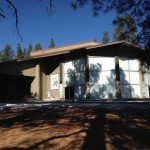 Coconino Center for the Arts in Flagstaff. Because the play deals with the issue of domestic violence, we are also working with the Northland Family Help Center, which will co-lead post-performance discussions.
Coconino Center for the Arts in Flagstaff. Because the play deals with the issue of domestic violence, we are also working with the Northland Family Help Center, which will co-lead post-performance discussions.
What an amazingly dedicated and talented group of young people to work with! I am in awe of their dedication and seriousness. And of the extraordinary work of their super drama teacher, Mike Levin.
A few weeks ago, when I read about the Tonys having created a new award to recognize Excellence in Theater Education, I immediately thought of Mike. We are now in the processing of nominating him for this much deserved recognition.
If you are near Flagstaff, please come see the show in March!
December 11, 2014
Long Hiatus/Much News!
Travel, workshops, and other writing obligations interfered with my ability to post a new entry. First, there was a workshop of Feminist Love Studies held in Örebro, Sweden at Örebro University. I presented a paper on my academic work related to the study of domestic violence and explored whether recent research in what is called “affect theory” has contributed or not to our understanding of this kind of trauma. (I was very critical of this new strand of research). We had lively discussions of my work, along with the papers of the other scholars in the group, who came from Austria, Mexico, Canada, and the U.S. to participate in the workshop. A new anthology of our essays will make its way into the world in a year or so.
I also presented a paper on my work on Arendt to a different group of interdisciplinary scholars at the same university. Then I flew to the east coast, where I led two writing workshops for undergraduates at Fairfield University in Connecticut. It was test time in the semester and their energy was low. But my colleague, Jocelyn Boryczka, who arranged my visit, told me the students expressed to her how much they’d gotten out of the exercises I gave them.
Jocelyn had also organized a lovely seminar with colleagues from across the campus, who had read Diving for Pearls. It was fantastic to engage in a discussion with a group who really appreciated the writing and my approach to bringing Arendt to a wider audience. One of the faculty, Sonya Huber, is herself a memoirist and I hope to collaborate with her in the future on our mutual interest in alternative academic writing, and exploring ways creative writing can bring critical issues and humanities subjects to life.
Recently, Diving for Pearls has had a bump in publicity thanks to the work of two amazing writers: Leora Skolkin-Smith and Elayne Clift, both of whom wrote extensively about my new work.
Leora Skolkin-Smith, author of the recently re-issued novel, Edges—a wonderfully evocative story about Israel in the 1960s wrapped around a young woman’s coming-of-age story. A truly lovely book that is being made into a feature film!—published a review of my work on ReadySteadyBook, a literary web site:
Jones’ rendering of Arendt is unabashedly personal, and her way is my way, too, of reading and identifying with the main character so to speak. Through a tunnel of empathy and identification we can journey with even one of the densest philosophic thinkers of our time, making her accessible and part of our own lives… If only more non-fiction biographies could combine the personal with the facts of a “great” person otherwise unreachable to us, I thought, as reading for me is always this process of identification and catharsis, a blending of the personal and hardcore factual world.
I was gratified by the moving way Leora Skolkin-Smith captured the essence of my writing.
Today, Elayne Clift, author of Hester’s Daughters and several collections of essays, as well as a regular columnist for the Daily Kos, posted a piece there on rethinking the “banality of evil.” To have my work situated as I had hoped in the context of how to think about complex moral and ethical problems we all confront in the news and in our own personal lives was gratifying.
I still await decisions in several book contests in which I entered Diving for Pearls. Although the book was a finalist in Red City Reviews’ contest, it didn’t win. I congratulate the winners and remain hopeful about the other competitions still to be decided. Today, I learned that my book was among those chosen as an IndieReader Best Books of 2014, in non-fiction category. Thanks, IndieReader!
Finally, for those of you interested in the topic of public scholarship, with which Arendt certainly engaged, I would like to draw your attention to a new research grant opportunity the NEH is sponsoring. As reported in the Washington Post yesterday, William Adams, the new Chair of NEH and former President of Colby College launched the Public Scholar program “to encourage, support and inspire humanities scholars to do a somewhat different kind of work than they have in the past . . . to make sure it meaningfully enters into the public realm where it can matter and have impact.”
Maybe some of you might consider applying to support your work?? I have a new idea, too, for this program….more on that later!
December 10, 2014
Long Hiatus/Much News!
Travel, workshops, and other writing obligations interfered with my ability to post a new entry. First, there was a workshop of Feminist Love Studies held in Örebro, Sweden at Örebro University. I presented a paper on my academic work related to the study of domestic violence and explored whether recent research in what is called “affect theory” has contributed or not to our understanding of this kind of trauma. (I was very critical of this new strand of research). We had lively discussions of my work, along with the papers of the other scholars in the group, who came from Austria, Mexico, Canada, and the U.S. to participate in the workshop. A new anthology of our essays will make its way into the world in a year or so.
I also presented a paper on my work on Arendt to a different group of interdisciplinary scholars at the same university. Then I flew to the east coast, where I led two writing workshops for undergraduates at Fairfield University in Connecticut. It was test time in the semester and their energy was low. But my colleague, Jocelyn Boryczka, who arranged my visit, told me the students expressed to her how much they’d gotten out of the exercises I gave them.
Jocelyn had also organized a lovely seminar with colleagues from across the campus, who had read Diving for Pearls. It was fantastic to engage in a discussion with a group who really appreciated the writing and my approach to bringing Arendt to a wider audience. One of the faculty, Sonya Huber, is herself a memoirist and I hope to collaborate with her in the future on our mutual interest in alternative academic writing, and exploring ways creative writing can bring critical issues and humanities subjects to life.
Recently, Diving for Pearls has had a bump in publicity thanks to the work of two amazing writers: Leora Skolkin-Smith and Elayne Clift, both of whom wrote extensively about my new work.
Leora Skolkin-Smith, author of the recently re-issued novel, Edges—a wonderfully evocative story about Israel in the 1960s wrapped around a young woman’s coming-of-age story. A truly lovely book that is being made into a feature film!—published a review of my work on ReadySteadyBook, a literary web site:
Jones’ rendering of Arendt is unabashedly personal, and her way is my way, too, of reading and identifying with the main character so to speak. Through a tunnel of empathy and identification we can journey with even one of the densest philosophic thinkers of our time, making her accessible and part of our own lives… If only more non-fiction biographies could combine the personal with the facts of a “great” person otherwise unreachable to us, I thought, as reading for me is always this process of identification and catharsis, a blending of the personal and hardcore factual world.
I was gratified by the moving way Leora Skolkin-Smith captured the essence of my writing.
Today, Elayne Clift, author of Hester’s Daughters and several collections of essays, as well as a regular columnist for the Daily Kos, posted a piece there on rethinking the “banality of evil.” To have my work situated as I had hoped in the context of how to think about complex moral and ethical problems we all confront in the news and in our own personal lives was gratifying.
I still await decisions in several book contests in which I entered Diving for Pearls. Although the book was a finalist in Red City Reviews’ contest, it didn’t win. I congratulate the winners and remain hopeful about the other competitions still to be decided.
Finally, for those of you interested in the topic of public scholarship, with which Arendt certainly engaged, I would like to draw your attention to a new research grant opportunity the NEH is sponsoring. As reported in the Washington Post yesterday, William Adams, the new Chair of NEH and former President of Colby College launched the Public Scholar program “to encourage, support and inspire humanities scholars to do a somewhat different kind of work than they have in the past . . . to make sure it meaningfully enters into the public realm where it can matter and have impact.”
Maybe some of you might consider applying to support your work?? I have a new idea, too, for this program….more on that later!

